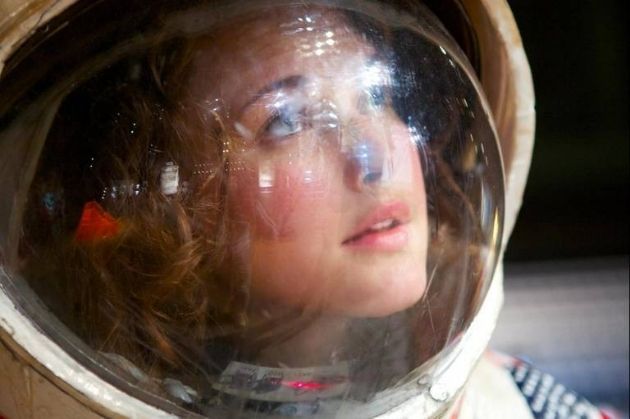A Space Program (2015) - Neistat

The moon landing conspiracy theories have been around -- and a constant subject for documentaries and narrative films -- since Neil Armstrong first walked on the moon in 1969.
The story goes that Stanley Kubrick was hired by NASA to fake it because they didn't have resources or technology and were on tight deadline from the commander in chief. It was the Cold War era and the space race was on full swing. There are at least a couple of movies that are already out about this very subject this year alone: Antoine Bardou Jacquet's Moonwalkers and Matt Johnson's Operation Avalanche.
In keeping with this tradition, A Space Program, directed by Van Neistat (HBO's The Neistat Brothers), documents Tom Sachs' 2012 interactive installation show Space Program 2.0: MARS in 33,000 square feet Park Avenue Armory in New York. Sachs, a sculptor known for his ironic take on brand name products via DIY means, set out to do a massive scale interactive show about a staged space mission to Mars with all the materials built from scratch.
Audiences were invited to experience a TV-studio-like fake retro Mars landing in all seriousness. The result was an entertaining spectacle of make-belief and a performance art on stage that successfully faked the NASA Control Room dramatics. Neistat, who with his brother Casey started his career making fun of Apple's lack of a battery replacement policy in a short video, is a good choice to chronicle Sachs' highly idiosyncratic endeavor.
The documentary covers the installation show in painstaking detail. Think of A Space Program as a DIY version (everything was built with plywood, tape and epoxy glue) of a Mars landing movie co-directed by Wes Anderson and Michel Gondry and you get the picture, perhaps slightly less whimsical. On stage, we see how things are laid out: a makeshift Control Room, working replica of life size Moon/Mars Lander, and surface of Mars all right next to each other.
The elaborate Control Room set up is quite impressive: multiple old style tube monitors with handwritten signs, switchboard and speakers manned by men (including Sachs) in white half-sleeve button down shirts, horn rimmed glasses and black ties. Many of them don big mustache and seizelessly smoke cigarettes. Everything is captured by DIY TV studio cameras and small handheld, wired DIY video cameras, from astronauts going into the lander (using the rickety ladders to climb up and into) to the launch of the historical Mars landing.
Glued to the grainy video feed on the big screen, they eat their McDonald's dinner. Our lovely astronauts are steel metal worker Sam (Sam Rataranat) and Carpenter Mary (Mary Eannarino). After the Wes Anderson style character introductions with their funny code names, brief bios and catchy visuals, the narrators put an emphasis on the mission's real mission: Putting the first woman on Mars.
Throughout the mission, we are informed with helpful hand drawn and physical instructions on the complicated inner-workings of tybek space suit, ingenuous compartmental system of Mars Lander interior, a shelf full of space-food (rows of whiskey bottles) and a graphic demonstration on how to use a space toilet.
A big globe is a stand-in for the mother earth. A giant unevenly shaped red ball is Mars. They simply fake the space travel with the combination of stock footage, pulling the small makeshift camera on a string and toy rockets on a wire with hand drawn, LED lit background.
As if these cool technical specifications and all the handmade gadgets aren't enough, we have Lt. Sam and Commander Mary's team dynamics battling for our attention. After their successful launch into space, they are seen tending to their lesbian tendencies rather than their astronaut duties. Once they get to Mars, tempers fly and blame games begin when the mission doesn't go as they planned (getting samples of Mars soil in search of intelligent life).
Our astronauts finally get the samples after digging through the Mars surface (the hardwood floor) with a hack saw and circular saw and send it back to earth in dramatic fashion while their oxygen running critically low. The entire Control Room team watches their mission on the big monitor, completely gripped. And live audiences watch them from their bleecher seat and we watch the whole thing on screen. Would they make it? This is a nail-biting, edge of your seat stuff!
A Space Program's charm largely depends on Sachs' ingenuous designs, his attention to details and playfulness- from life size Mars Landers to plywood constructed, red painted Mars rocks to fake seriousness of his crew. His ironic take on name branding, this time the NASA logo, is seen everywhere- the space suit, the Lander, tumblers on the desks and many more. Neistat's snappy visual style is a good match for Sachs' idiosyncratic creations. The film isgreat fun.
A Space Program opens on March 18 at Metrograph in New York and April 7 at Cinefamily in Los Angeles. Zeitgeist Films is releasing the film. Please visit their website for more roll out dates and other information.

